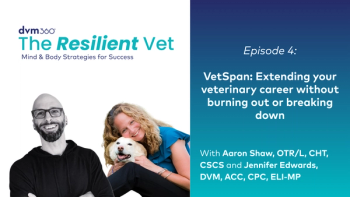
Dark shadows: Drug abuse and addiction in the veterinary workplace
Whether its suicidal thoughts or drug addiction haunting our colleagues, are we doing enough to protect them from themselves ... and offering them the resources to get the help they need?
(Photo Getty Images)There is a dangerous, sometimes fatal paradox at the heart of our veterinary profession. First, veterinarians experience far higher than average levels of workplace stress, depression and suicidal ideation, and they have increased access to potentially addictive and deadly drugs. That said, little drug testing is conducted in veterinary workplaces, drug control procedures are relatively lax, and employee assistance programs are few and far between. Vulnerability and access lead to a high risk of abuse and addiction in the veterinary workplace.
Are we recognizing the danger of this paradox -- mental health problems and access to drugs -- that puts our colleagues in harm's way? And will we do something about it?
25 to 40 times more potent than heroin
Reforming your drug procedures
"I thought narcotic theft at my veterinary practice was unlikely, but I learned the hard way that no one is immune," says veterinary practice owner Kathryn Primm, DVM. "Because of my recent issue, I had to learn a lot and 'on the spot.'"
You may be familiar with the epidemic in heroin usage in the United States. Availability of the drug is up across the country, as are incidents of abuse, overdose and overdose-related deaths. A recent survey by the Substance Abuse and Mental Health Services Administration (SAMHSA) showed a 51 percent increase between 2013 and 2014 in the number of heroin users (people who reported using heroin within the last 30 days), and the same agency has reported that heroin seizures have nearly doubled since 2010, from 2,763 kilograms to 5,013 kilograms in 2014.
But it's not just heroin. The Centers for Disease Control and Prevention (CDC) reports that fentanyl, a synthetic opioid 25 to 40 times more potent than heroin, has caused more than 700 deaths in the United States between late 2013 and early 2015. Fentanyl is sometimes added to heroin batches, or sold by itself as heroin, unknown to the user, according to the CDC.
Doctor's little helper
A DVM's drug cabinet
An incomplete list of mind-altering, potentially addictive drugs kept on hand in veterinary practices.
Controlled
Fentanyl
Methadone
Morphine
Hydromorphone
Oxymorphone
Buprenorphine
Butorphanol
Phenobarbital
Pentobarbital
Euthanasia solution
Ketamine
Diazepam
Midazolam
Alfaxalone
Tramadol
Hydrocodone
Naloxone
Tiletamine-zolazepam (Telazol)
Non-controlled
Naloxone
Propofol
Dexmedetomidine
Gabapentin
Amantadine
Trazodone
Veterinarians and their staffs have access to a large variety of mind-altering, potentially addictive drugs, including controlled as well as non-controlled substances (see "A DVM's drug cabinet" at right). They also face well-documented job stresses as a result of long hours, challenging cases, difficult clients, economic challenges and the emotional consequences of performing animal euthanasia.
A
These stressors create a significant layer of drug abuse risk in the veterinary workplace in addition to those posed by current drug users seeking employment in a workplace where psychoactive drugs are comparatively available.
In June 2015 I developed a survey with Lori Kogan, PhD, a licensed clinical psychologist at the Colorado State College of Veterinary Medicine. The
Don't believe you could ever have a problem with drug addicts in your hospital? Are you certain you're so skilled an employer that you would never hire a drug user? Let's take a look at human medicine, where transgressions usually lead to well-publicized disasters. Do not underestimate the power of addiction.
Nurses on narcotics
Drug test data
When positivity is a bad thing ...
Positive results to drug tests are increasing significantly. Quest Diagnostics, which conducts drug testing, has reported that the positivity rate for roughly 6.6 million urine drug tests in the general workforce increased overall by 9 percent -- to 4.7 percent positives in 2014 compared with 4.3 percent positives in 2013. This means that for every 20 employees in a practice, one is likely to test positive for illicit drugs. In a practice of 100 employees, expect at least four to test positive -- with half of those for drugs other than marijuana.
In January 2016, Rocky Allen, a surgical nurse at Swedish Medical Center in Englewood, Colorado, was preparing a constant-rate infusion (CRI) of fentanyl citrate for a patient for orthopedic surgery, according to local media reports. Allen, 28, took one of the vials of fentanyl and injected himself. He replaced the contents of the vial with saline, with the same syringe and needle he'd just used. During Allen's time working at the hospital, as many as 2,900 patients may have received saline tainted with his blood and were asked to be tested for hepatitis C. In addition, many of these patients were receiving saline as their primary pain medication during the orthopedic procedures.
Ashton Daigle, a Boulder, Colorado, nurse, was sentenced to 4.5 years in a federal prison after roughly 290 people received what was labeled as fentanyl but was actually saline or tap water, according to local reports. Between Oct. 13 and 17, 2008, Daigle accessed a dispensing machine as many as 25 times in one day. Using the same needle he used to withdraw the fentanyl from the original vials, he injected himself and in turn used that needle to replace the contents of the vials with either saline solution or nonsterile tap water. He then used surgical glue to reattach the tamper-resistant cap prior to replacing the fentanyl vial back in the machine.
The story of drug addiction and dangerous medical care repeats itself in December 2013, when former hospital worker David Kwiatkowski was sentenced to 39 years for using stolen fentanyl syringes to inject himself and then filling the tainted syringes with saline for use in medical procedures. In 2010, Kwiatkowski had been fired from an Arizona hospital after a fellow employee found him passed out in the men's room with a syringe floating in the toilet, according to CNN.
While many of these kinds of reports have surfaced in the healthcare industry, little is heard in the veterinary world. I suspect that's not because abuse isn't happening but rather because abusers take advantage of lax controls and minimal reporting requirements in the veterinary workplace.
PROBLEM 1: Little testing
The pot problem
In states where recreational or medicinal marijuana is legal, should veterinary practices screen for tetrahydrocannabinol among their medical staff?
Marijuana is by far the most common drug that comes back positive on urine tests, followed by opiates, barbiturates, cocaine and methadone. So is marijuana use among veterinarians, technicians and other staff a problem?
In Colorado, a major test case was resolved in 2015 when courts ruled that an employer was allowed to terminate an employee for testing positive for THC, even though that employee had a valid medical-marijuana usage card and only used marijuana off-hours. This judgment was justified as upholding federal law, which still classifies THC as a Schedule 1 controlled substance and considers the use of marijuana illegal.
The question gets even trickier when it comes to healthcare workers. In some states, such as Colorado, physicians are considered "unfit to practice medicine" if they test positive for THC at any time, regardless of permitted medical and recreational usage. In my survey reported in the September 2015 issue of JAVMA, 50 percent of respondents agreed that veterinarians should be held to that same standard.
THC users will usually test positive for up to 24 hours after smoking a marijuana cigarette, and in testing done with pilots on simulators, small amounts of THC in the bloodstream were correlated with impaired judgement and slower reflexes, according to a study published in 1985 in the American Journal of Psychiatry.
Physicians, like pilots, are considered to be in a safety-sensitive work environment, where public safety concerns trump a physician's individual rights. Some in veterinary medicine might argue that we are not in a public-safety profession. Perhaps it will be left up to pet owners to decide.
Employee drug testing can help deter and screen out drug users and potential addicts yet is seldom conducted in veterinary hospitals. In the survey of veterinarians and staff members I conducted in June 2015, respondents indicated that drug testing was performed in less than 30 percent of hospitals. Compare that to an overall 60 percent of private businesses and almost all federal agencies. Here are five common types of employer-driven drug testing:
> pre-employment
> random screening
> post-accident
> for reasonable suspicion
> return to work.
My survey also showed that 18 percent of veterinary hospitals perform pre-employment testing and testing "for reasonable suspicion," but only 8 percent of hospitals perform random testing. In 7 percent of hospitals, veterinarians were excluded from drug testing, although this may violate employment law in some states.
Based on responses to the survey, random drug testing-in which employees are randomly required to undergo a urine drug screen-is considered the most effective form of ongoing monitoring for illicit drug use by many practice owners, but it's controversial because it can create a culture of distrust within a hospital. Many practice owners consider it not worth the ill will created.
PROBLEM 2: Light drug control
In busy practices -- especially 24-hour practices taking emergencies -- access to controlled drugs may not be as limited as we'd like. With seizing pets, major emergency surgeries, traumatic injuries and other emergent or urgent cases, controlled drugs are often left out to be ready for immediate use -- and, unfortunately, potential theft.
My 2015 survey found that, in veterinary practices, access to drug cabinets or safes was under the control of authorized users 82 percent of the time. The drug cabinet or safe was located in a place with limited access during normal work hours only 68 percent of the time. Control of refrigerated drugs was particularly lax, with respondents reporting that all controlled substances requiring refrigeration were stored in locked containers securely fastened within a refrigeration unit only 45 percent of the time.
PROBLEM 3: Inconsistent assistance
How teams help stop drug theft
Kathryn Primm, DVM, shares some tips on better drug inventory control to prevent theft and abuse at
Employee assistance programs for substance abuse problems differ from state to state. Colorado, for instance, charges veterinary team members for services, but veterinarians are covered at no cost. In other states, employee assistance programs are required to report any issues regarding drug abuse or addiction to the state board, often resulting in license censure or suspension.
Only 26 percent of respondents to my survey last year said an employee assistance program was available in their state, and 40 percent didn't know either way. A national program, perhaps sponsored by the AVMA, could be created to provide consistent support, without legal or licensure repercussions, to those who qualify.
Veterinary employers have an obligation to their teams to provide a safe and drug-free workplace. Furthermore, they need to provide support to those who have a problem with drug abuse and addiction, especially if that problem is a result of job-related stressors and vulnerability combined with access to psychoactive drugs and medications. It's time to address this problem head on and bring the stigma of drug abuse and addiction out of the shadows.
Jon Geller, DVM, DABVP, CVJ, is hospital director at Fort Collins Veterinary Emergency and Rehabilitation Hospital in Fort Collins, Colorado.
Newsletter
From exam room tips to practice management insights, get trusted veterinary news delivered straight to your inbox—subscribe to dvm360.






